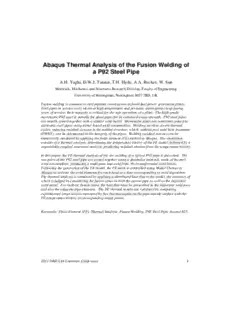
Yaghi - Abaqus Thermal Analysis of the Fusion Welding of a P92 PDF
Preview Yaghi - Abaqus Thermal Analysis of the Fusion Welding of a P92
Abaqus Thermal Analysis of the Fusion Welding of a P92 Steel Pipe A.H.Yaghi,D.W.J.Tanner,T.H.Hyde,A.A.Becker, W. Sun Materials,MechanicsandStructuresResearchDivision,FacultyofEngineering UniversityofNottingham,NottinghamNG72RD,UK Fusionweldingiscommoninsteelpipelineconstructioninfossil-fuelpowergenerationplants. Steelpipesinservicecarrysteamathightemperatureandpressure,undergoingcreepduring yearsofservice;theirintegrityiscriticalforthesafeoperationofaplant. Thehigh-grade martensiticP92steelissuitableforplantpipesforitsenhancedcreepstrength. P92steelpipes areusuallyjoinedtogetherwithasimilarweldmetal. Martensiticpipesaresometimesjoinedto austeniticsteelpipesusingnickelbasedweldconsumables. Weldinginvolvesseverethermal cycles,inducingresidualstressesintheweldedstructure,which,withoutpostweldheattreatment (PWHT),canbedetrimentaltotheintegrityofthepipes. Weldingresidualstressescanbe numericallysimulatedbyapplyingthefiniteelement(FE)methodinAbaqus. Thesimulation consistsofathermalanalysis,determiningthetemperaturehistoryoftheFEmodel,followedbya sequentially-coupledstructuralanalysis,predictingresidualstressesfromthetemperaturehistory. Inthispaper,theFEthermalanalysisofthearcweldingofatypicalP92pipeispresented. The twopartsoftheP92steelpipearejoinedtogetherusingadissimilarmaterial,madeofInconel weldconsumables,producingamulti-passbuttweldfrom36circumferentialweldbeads. FollowingthegenerationoftheFEmodel,theFEmeshiscontrolledusingModelChangein Abaqustoactivatetheweldelementsforeachbeadatatimecorrespondingtowelddeposition. Thethermalanalysisissimulatedbyapplyingadistributedheatfluxtothemodel,theaccuracyof whichisjudgedbyconsideringthefusionzonesinboththeparentpipeaswellasthedeposited weldmetal. Forrealisticfusionzones,theheatfluxmustbeprescribedinthedepositedweldpass andalsotheadjacentpipeelements. TheFEthermalresultsarevalidatedbycomparing experimentaltemperaturesmeasuredbyfivethermocouplesonthepipeoutsidesurfacewiththe FEtemperaturehistoryatcorrespondingnodalpoints. Keywords:FiniteElement(FE),ThermalAnalysis,FusionWelding,P92SteelPipe,Inconel625. 2011SIMULIACustomerConference 1 1. Introduction Thenumericalsimulationoftheprocessoffusionweldingofsteelpipesinpowergeneration plantshasbeenthesubjectofresearchandpublicationforafewdecades. Steelpipesarean essentialcomponentinfossil-fuelandotherpowerplants,deliveringsteamathightemperature andpressure. Theconstructionofthepipesrequiresjoiningthembyapplyingfusionwelding, involvingintensethermalcycles,causingrapidheatingandcoolingoftheweldedmetal. This inducesresidualstressesintheweldmaterialandtheheataffectedzone(HAZ)ofthepipes,which usuallyexceedthematerialyieldstressatcertainlocations. Thelargemagnitudeofthewelding- inducedresidualstressescanbedetrimentaltothemechanicalperformanceofthewelded componentsduringservice. Thisproblemisusuallyovercomebythepost-weldheattreatment (PWHT)oftheweldedpipes,whichiscostlyandcanbetechnicallychallenging;PWHT significantlyreducesthemagnitudeofresidualstressesbutitcannoteliminatethem. Therefore, thedeterminationofresidualstressesthroughouttheweldedpipescanbevaluablefordeciding howtoapplyPWHTorindeedhowtomodifyweldingprocedurestomitigatetheill-effectsof residualstresses. Thedeterminationofresidualstressesinweldedpipescanbeachievedbyexperimental procedures,suchastechniquesbasedoncentre-holedrilling,deep-holedrilling,X-raydiffraction andneutrondiffraction,whicharecostlyanddifficultattimes,andcaninvolvedestructiveor semi-destructiveprocedures,otherwisetherevealedstressfieldislimitedtothesurfaceornearthe surface(Yaghi,2010). Theexperimentally-determinedresidualstressfieldismeasuredatspecific locationsonlyandtheexperimentalmethodsinvolveaveragingoveranarea,possiblymissingout onsharpchangesintheresidualstressfieldwhicharetypicalofwhatisinducedbytheprocessof welding. Thefiniteelement(FE)numericalmethod,however,canprovideresidualstress predictionsthroughouttheweldedcomponent,capturingthesharppeaksofthestressfield, dependingontherefinementofthegeneratedFEmesh. Thechallengingpartofproviding accuratenumericalresultsliesinacquiringasetofmaterialpropertieswhichtrulyreflectthe behaviourofthemodelledmaterial. Iftherequiredsetofmaterialpropertiesforthenumerical simulationisavailableandthegeneratedFEmeshhassufficientrefinement,theresidualstress fieldduetoweldingcanbeaccuratelyobtainedthroughouttheFEmodel,makingtheFEmethod highlyeffectiveatpredictingweldingresidualstresses. TheFEmethodcomprisestwoparts:athermalanalysis,simulatingtheweldingthermalcycles anddeliveringatemperaturehistorythroughouttheweldingprocess,andasequentially-coupled structuralanalysis,processingthetemperaturehistoryasinputdataanddeterminingthe developingthermalstressesandtheresidualstressfieldinducedbythethermalcycles. Evidently, theaccuracyofresidualstressesisdependentontheaccuracyofthetemperaturehistory determinedbythethermalanalysis. Inthispaper,thethermalanalysisofanarcweldedsteelpipe, typicallyfoundinpowergenerationplants,ispresented. ThepipeismadeofP92steelandis dissimilarinthesensethattheweldmetalisdifferentfromthetwoP92partsbeingjoined together. P92steelpipesareusuallyjoinedtogetherwithasimilarweldmetal. Martensiticpipes aresometimesjoinedtoausteniticsteelpipesusingnickelbasedweldconsumables. Inthisstudy, theP92steelpipehasbeenweldedwithadissimilarweldmetalforresearchpurposes. Theweld 2 2011SIMULIACustomerConference isacircumferentialbutt-weldconsistingof36beads. Thefirstbeadorweldpassismadeof Inconel82(IN82)andtheremaining35beadsorweldpassesaremadeofInconel625(IN625). P92,alsoknownasNF616inJapan,isarelativelynewly-developed9-12%Crferriticsteelthat canbeusedinhightemperatureapplications,suchasinfossil-fuelandnuclearpowerstationsas wellaschemicalplants. P92isamodifiedformofitspredecessorP91. Molybdenum,Mo,inP91 (9Cr1Mo)hasbeenpartiallyreplacedbyTungsten,W,forP92(9Cr2W). P92hascreepstrength approximately30%higherthanthecurrentlywidelyusedsteelP91(Brózda,2005),andithas provedsuitableforpipingandheadersattemperaturesuptoaround625°C(Richardot,2000). Hence,inmodernsuper-criticalsteampowerplants,P92allowshigheroperatingparametersand thereforehigherefficiencies. Ingeneral,anFEsimulationofaweldedpipecanbethree-dimensional(3D)or,whenappropriate, canbetwo-dimensional(2D)axisymmetric(Deng,2006). A3Dsimulationisdesirablewhen effectsthatcannotbeotherwisemodelledarerevealed,suchasstressesatweldingstartingand stoppinglocations. A2Daxisymmetricsimulation,however,canbemoresuitable,whensuch effectsaretobeignored,andwhenthemoreuniformresidualstressfieldisofinterest. Thisis becausea2DaxisymmetricsimulationcanhaveamuchfinerFEmeshforthesamecomputational processingtimeincomparisonwitha3Dsimulationofthesamemodel,whichcanleadto significantlymoreaccurateresultsforlargemodelswithnumerousweldpasses. 3Dmodelsof weldswithmanypassescanovercomethenecessityofrunningprohibitivelylargeanalysesby employingtechniquessuchaslumpingoftheweldpassestogetherandkeepingtheFEmesh relativelycoarse,whichwouldreducetheaccuracyoftheresults. Figure1. P92pipebeforewelding. Thereportedthermalanalysisisbasedona2Daxisymmetricmodeloftheweldedpipewiththe FEmeshcontrolledusingthefacilitynamedModelChangeinAbaqus(ABAQUSUserManual, 2009). ModelChangeallowstheweldmaterialforeachweldpasstobecomeactiveduringthe numericalsimulationatthetimecorrespondingtothedepositionofthepass. Theheatdelivered bytheweldingarchasbeenmodelledbyprescribingauniformlydistributedheatflux,whichisa 2011SIMULIACustomerConference 3 triangularfunctionagainsttime,correspondingtotheapproachingandthendepartingweldingarc. Thedistributedheatfluxhasbeenappliedtoeachweldpasswhenitisdepositedandalsotothe surroundingpipe(parent)materialinordertoobtainthedesiredthermalcontoursintheFEmodel. IntheFEthermalstudy,considerationhasbeengiventofusionzonesintheweldandparent material,peaktemperaturecontoursthroughouttheHAZandthetemperaturehistoryatlocations correspondingtoasetofattachedthermocouples. Theactualweldedpipehadfivethermocouples attachedatdifferentlocations,makingitpossibletovalidatethetemperaturehistorydetermined bythereportedFEthermalanalysis. 2. Dissimilar Welded Pipe TheFEthermalanalysishasbeenconductedtomodelthethermalbehaviourofaweldedsteel pipe. Priortowelding,theP92pipewascutintotwohalvesandtheendspreparedforjoining,a photographofwhichisshowninFigure1. Thetwohaveswereaxisymmetricallyalignedandheld inlargemetalvicesandthenweldedtogetherusing36weldbeads(orpasses)ofdissimilarweld materials. Theright-handsidewasreleasedafterthethirdweldpasshadbeencompleted,andthe left-handsideremainedfixedthroughouttheprocessofwelding,ascanbeseeninFigure2. Figure2. P92pipeduringwelding. 2.1 PipeGeometry,WeldDetailsandMaterialSpecifications ThegeometryanddimensionsoftheweldedP92pipe,aswellastheweldingsequence,areshown inFigure3. Theweldedpipehasanoutsidediameterof355mmandatotallengthof700mm. Thefirstweldpasswasdepositedbytungsteninertgas(TIG)weldingusingthenickelbasedweld materialInconel82(IN82),havingthemanufacturer’sbrandnameUTPA068HH,witharod diameterof2.4mm,duringwhichargongaswasusedtoshieldtheweldfromatmosphericgases. Weldpasses2to36weredepositedbymanualmetalarc(MMA)weldingusingthenickelbased weldmaterialInconel625(IN625),havingthemanufacturer’sbrandnameNIMROD625KS, 4 2011SIMULIACustomerConference withthefillerrodforweldpasses2and3havingadiameterof3.2mmandtheremainingpasses havingadiameterof4.0mm. Thechemicalcompositionsfortheparentandweldmaterialsare showninTable1. Thematerialpropertiesarediscussedinsection3.2. 32mm 28mm 32 34 35 36 33 2.0-2.5mm 28 30 31 29 24 26 27 25 20 22 23 21 19 17 18 30mm 14 16 15 13 15° 11 12 10 8 9 6 7 4 5 4.35mm 2 3 1mm 30° 1 1.5mm 3mm Figure3. Sketchofweldbeadsequenceshowingoverallwelddimensions. Table1. Chemicalcompositionofthepipeandweldmaterials. Fe C Mn P S Si Cr W Mo V Nb N B Al Ni P92 Bal 0.10 0.45 0.015 0.002 0.45 8.62 1.86 0.33 0.21 0.076 0.047 0.003 0.019 0.27 IN625 1.48 0.03 0.76 0.005 0.005 0.33 21.9 - 8.67 - 3.340 - - - Bal IN82 0.80 0.01 3.00 - - 0.10 20.0 - - - 2.700 - - - Bal 2.2 ThermocouplesandWeldProcedure Thetemperatureofthepipewasmonitoredduringweldingbyattachingfivethermocouplestothe surfaceofthepipeandrecordingthetemperatureswithachartplotterthroughoutthewelding process. Thethermocouplesmeasuredthesurfacetemperatureatfivedifferentlocationswith varyingdistancefromtheweldcentreline(WCL)andalsoatdifferentangularpositionsaround thepipecircumference. SincetheFEanalysisisaxisymmetric,theangularpositionofthe thermocouplesaroundthecircumferenceisirrelevanttothereportedstudy. Thefactthatthe angularpositionvariesforthethermocouples,however,isrelevantinexplainingsomeofthe scatternoticedinthetemperatureresultsaswellassomeofthediscrepanciesobservedbetween theexperimentallymeasuredandtheFEdeterminedtemperatures,aswillbediscussedlaterinthe paper. Thermocouples1and2(TC1andTC2)areclosesttotheweldandarelocatedontheleft- handpipesection,bothatanaxialdistanceof32.4mmfromtheWCL. Theotherthermocouples, 2011SIMULIACustomerConference 5 TC3,TC4andTC5,arelocatedontheright-handpipesectionataxialdistancesof35.0mm, 40.5mmand70.3mmfromtheWCLrespectively. Allthedistancesweremeasuredafter depositingthethirdweldpassandbeforetherestofthepassesweredeposited,i.e.beforeany significantdeformationtookplace. Itisworthnotingthatthedistancesrelatingtothe thermocouplesareaccuratetowithin±0.5mm;theyare,however,quotedheretothestated precisiontocorrespondtothematchingnodalpositionsintheFEmesh,wheretemperature comparisonsaremade. Thethermocoupleswereusedtomonitorthetemperatureofthepipetomaintaintherequired preheatandinterpasstemperature,necessaryinthecaseofP92steelforaweldingprocedure whichwouldlikelybefreefromtheriskofmicroormacro-crackingduringweldingorjustafter, asthepipecooledtoroomtemperature. Thetemperaturehistoryobtainedfromthethermocouples hasalsobeenusedtovalidatethethermalbehaviourdeterminedbytheFEsimulation. Thepipe washeatedbyanelectricblanketonbothsidesascanbeseeninFigure2. Althoughtheblanket wouldgoonandoffandwouldreachrelativelyhightemperatureswhenswitchedon,the temperaturesattheweldregionandtheHAZwererelativelysteady,andthereforetheFE modellingoftheblanketeffectwasachievedbyprescribingasinktemperatureatthesurface wheretheblanketwasincontactwiththepipe. Thesinktemperaturewasvariedfromoneweld passtotheother,duringtheFEsimulation,toemulatetheexperimentallymeasuredtemperatures duringtheinterpassperiods. Duringtheactualweldingofthepipe,asrecommendedbyliterature, itwasaimedtokeepthepreheatandinterpasstemperaturesfortheTIGweldingofthefirstpass between100°Cand150°C(Holloway,2008)andfortheMMAweldingofalltheotherpasses between200°Cand250°C(Richardot,2000). 3. FE Thermal Analysis TheFEthermalanalysisreportedinthispaperispartofamorecompleteFEsimulationintended bytheauthorstodetermineweldingresidualstressesforthedissimilarweldedP92pipe. TheFE thermalanalysis,whichformsthefirstpartofthesimulation,isreportedhere,whereasthe sequentiallycoupledstructuralanalysis,whichformsthesecondpartofthesimulation,istobe reportedinafuturepublication. Thetypeofsimulationadoptedbytheauthorsisdescribedas solid-mechanical,modellingtheheatfluxdeliveredtothepipebytheheatsourceandallowingfor thethermo-physicalbehaviour,suchasconductivity,andthentranslatingthethermaleffectsinto structuralmechanicaleffects,suchasvolumeexpansionsandplasticity,withoutallowingforany fluideffectsofthemoltenregions. Thesolidmechanicsapproachisjustifiedinignoringthefluid effects,sincestressesbecomesignificantonlywhenthematerialhassolidifiedandisrelatively cool. Whenthematerialismoltenorclosetobeingmolten,itissoftenoughnottosustainany significantstresses. Aslongasthemechanicalpropertiesusedinthesimulationrepresentthe actualbehaviourofthematerial,fluideffectsdonothavetobetakenintoconsideration. 3.1 FEModeloftheWeldedPipe TheFEsimulationofthefusionweldingofthedissimilarweldedP92pipestartswithgenerating anFEmodelbyfirstlycreatinganFEmesh. Thecommercialpackageusedforthispurposeand indeedforperformingthecompleteFEthermalanalysis,reportedinthispaper,isAbaqus 6 2011SIMULIACustomerConference (ABAQUSUserManual,2009). AcompleteFEmeshhasbeengeneratedfromthestart,which includesthepipeandtheweldregion. TheweldpasssequenceintheFEmodelisidenticaltothatintheactualweld,asshowninFigure 4. TheshapeoftheweldpassesintheFEmodeldoesnothavetoaccuratelymatchtheactual shapeoftheweldbeadstoproducerepresentativeandrealisticthermalcontours(Yaghi,2010). AlthoughtheshapesoftheFEpassesarerathersquarecomparedtotheactualweld,theresulting thermalcontoursemergeroundedandrealistic.Nonetheless,itisbelievedthatthefinallayerof weldpasseshasthemostsignificanteffectonresidualstresses,andthereforeanattempthasbeen madetomakethefinallayercloserinshapetotheactualweldbeads. Theshapeofthefinallayer ofbeadscaneasilybeadjustedwithoutundulycomplicatingtheFEmodel,whichisnotthecase fortheotherbeads. TheactualFEmeshwhichhasbeengeneratedforthemodelisshownin Figures5and6. ItcanbeseeninFigure5thatthemeshisrefinedintheweldregionandHAZ andthatitbecomesgraduallycoarserasitmovesawayfromtheweld,asshowninFigure6. The complete2DaxisymmetricFEmeshcomprises9022nodesand2919elements. Theelementtype usedthroughouttheFEmodelisaneight-nodecontinuumsolidquadraticaxisymmetricdiffusive heattransferquadrilateral,giventhenameDCAX8inAbaqus. Figure4. WeldpasssequenceintheFEmodel. TheelementsintheFEmeshformingeachweldpassareassignedagroupnamesothateachpass canbedepositedindependentlyduringthesimulation. Attheinceptionofthesimulation,the elementsofalltheweldpassesaremadetobecomeinactive,renderingthemthermallydormant, whilestillkeepingalltheelementsofthemeshattachedtogether. ThisisachievedinAbaqusby usingthecommand“ModelChange,Type=Element,Remove”atthebeginningofthefirststepin theinputfileofthethermalanalysis. Eachweldpassisdepositedinthecorrespondingstepinthe thermalanalysisbyusingthecommand“ModelChange,Type=Element,Add”,whichreactivates thecorrespondingelementsintheFEmesh. 2011SIMULIACustomerConference 7 Figure5. FEmeshshowingtheweld,HAZandpartofthepipe. TherequirementoftheFEmodeltoexchangeheat,atitssurface,withthesurrounding environmentisfacilitatedusingtheoption“sfilm”intheinputfile. Asurfacefilmor“sfilm”is generatedbyselectingtheoutsidesurfaceofrelevantelementswhichareexpectedtoexchange heatwiththesurroundingsbyconvectionandradiationorduetodirectcontactwithasolid materialasinthecaseoftheelectricblanket. Thesurfacefilmisspecifiedandthefilmproperties areassignedvaluestoallowappropriateamountofheattobeexchangedatthesurface. The temperatureoftheenvironmentsurroundingthemodelisspecifiedbyprescribingasink temperatureattherelevantsurfaces. Therefore,byspecifyingsetsofsurfacefilmsandfilm properties,theFEmodelcanexchangeheatwiththesurroundings,simulatingtheheatflow betweenthesurfaceofthemodelandtheenvironment,whetherthesurfacebelongstotheweldor pipe,andalsobetweenthepipeandtheelectricblanket. Thesurfacefilmismadetofollowthe evolutionoftheoutsidesurfaceasthedepositionofeachweldpassissimulated. Figure6. Complete2DaxisymmetricFEmesh. 3.2 MaterialProperties ThematerialpropertydatarequiredfortheFEthermalanalysishavebeenobtainedforthree differentmaterials,namely,P92steel,Inconel82(IN82)andInconel625(IN625). Someofthe dataareavailableinliterature,butsomehavebeenderivedeitherbyextrapolationtohigher temperaturesorbyreferringtoothersimilarmaterialswithknownmaterialpropertydata. This 8 2011SIMULIACustomerConference approachhasbeenadopted,sinceparametricanalysesbytheauthorsofweldingresidualstresses fordifferentmaterialshaveindicatedthatweldingresidualstressesingeneralaremostlysensitive tothevalueofyieldstressaswellasthatofthecoefficientoflinearthermalexpansion(whichare partoftheFEstructuralanalysis);theyaresignificantlylesssensitivetochangesinthermal properties;moreover,heatfluxeswouldhavetobeadjustedtoobtainrealisticmoltenzones,which wouldinturncompensateforinaccuraciesinthethermalproperties. Ithasalsobeenpossibleto calculatemeltingtemperaturesfromthermodynamicsoftwarepackages. Thematerialproperties thatneedtobespecifiedinthethermalanalysisarethethermalconductivity,density,specificheat capacity,latentheatcapacity,solidusandliquidustemperaturesandheattransfercoefficients. Figure7. ThermalconductivityandspecificheatcapacityintheFEmodel. ThethermalconductivityofP92steelhasbeenassumedtobethesameasthatforP91steel,which isavailableinliterature(Yaghi,2010). ThespecificheatcapacityofP92steelhasbeenobtained fromliterature(Richardot,2000)fromroomtemperatureupto650°C,abovewhichithasbeen assumedtoremainunchanged. BothmaterialpropertiesareshowninFigure7. Thesolidusand liquidustemperaturesforP92steelhavebeencalculatedas1420°Cand1500°Cbyusing MTDATAsoftwaredevelopedattheNationalPhysicalLaboratory(NPL)intheUKandtheyhave beencorroboratedbythesamevaluespublishedforP91steel(Yaghi,2010). ThedensityforP92 steelisspecifiedinliterature(Richardot,2000)as7850kg/m3. ThelatentheatcapacityforP92 steelhasbeenassumedtobethesameasthatforP91steel,specifiedas260kJ/kg(Yaghi,2010). ThethermalconductivityandspecificheatcapacityofIN625areprovidedinliterature(Special Metals,2006)fortemperaturesupto982°Cand1093°Crespectively. Thesamevalueshavebeen assumedfortheweldmaterialNIMROD625KSforthegiventemperaturerange,abovewhichthe twothermalpropertiesareassumedtoremainconstantuptothemeltingpoint. Asthematerial goesfromthesolidustotheliquidustemperature,thethermalconductivityisdoubledin magnitudetocompensateforthestirringeffectsinthemoltenstate(Brickstad,1998). Thesame thermalconductivityandspecificheatcapacityhavebeenassumedfortheweldmaterialUTP 2011SIMULIACustomerConference 9 A068HHusedforthefirstpassduetothelackofdataforIN82. Itisworthnotingthattheeffect ofthefirstweldpassonresidualstressesneartheoutsidesurfaceofthepipe,wheremostinterest liesforsuchwallthickness,isexpectedtobenegligible. Thethermalconductivityandspecific heatcapacityfortheweldmaterialsareshowninFigure7. ThedensityforIN625isgivenas 8440kg/m3(SpecialMetals,2006). Thisvaluehasbeenassumedforbothweldmaterials. The latentheatcapacityforpurenickelislistedas297kJ/kg(TheEngineeringToolBox,cited2011). Therefore,anapproximateandintermediatevaluebetweenthoseofP92steelandpurenickelof 280kJ/kghasbeenassumedfortheweldmaterials. Thesolidusandliquidustemperaturesfor UTPA068HHhavebeencalculatedtobe1301°Cand1368°CandforNIMROD625KStobe 1250°Cand1345°Crespectively,usingthesoftwareThermoCalcClassicVersionS(TCC), developedbytheFoundationofComputationalThermodynamicsinStockholmofSweden,and utilisingThermotechNickelsDatabaseVersion7(TTNi7)(Saunders,1996). Heatlossesatthesurfaceofthepipehavebeenmodelledbyprescribingappropriatevaluesforthe coefficientofheattransferundertheAbaquscommandFilmProperty. Heatlosscoefficientsfor P92steelandalsotheInconelweldmaterialhavebeenassumedtobethesameasthoseforP91 steel,giveninliterature(Yaghi,2005)tobe0.0668T(W/m2K)whenthetemperatureTisbelow 500°Cand0.231T–82.1(W/m2K)whenTisabove500°C. Asimilarapproachhasbeenadopted tomodeltheeffectoftheelectricblanketonthepipe. Recognisingthattheblanketwould fluctuateintemperaturesubstantiallyandwouldbeswitchingonandofftocontroltheinterpass temperatureduringwelding,themodellinghasbeensimplifiedtohavingtheblanketataconstant temperatureduringthedepositionofanyoneweldpass,prescribingaveryhighvaluetothe coefficientofheattransferatthesurfacewithwhichtheblankethascontact,andcontrollingthe sinktemperatureatthatsurfacetoobtainthedesiredtemperaturehistoryatthefive thermocouples. Thevalueprescribedforthecoefficientofheattransferforthispurposeis200T (W/m2K),whereTisthetemperatureofthepipe. 3.3 HeatFluxesandFusionZonesintheFEModel Themainpartofthethermalanalysisistomodeltheeffectoftheheatsourceonthepipeduring fusionwelding,i.e.theheatdeliveredbytheweldingarcintotheweldandsurroundingmaterial. Thishasbeencoveredindetailforsimilarweldedpipesinapreviouspublication(Yaghi,2005). Themodellingmethod,however,needstobemodifiedforthethermalanalysisofadissimilar weldedpipe,asisthecasehere. Ingeneral,theheateffectoftheweldingarconapipecanbemodelledbyprescribingauniformly distributedheatflux(DfluxinAbaqus)foreachoftheweldpassesastheyaredeposited. Inthe reportedwork,thefluxisassumedtofollowatriangularfunction(Yaghi,2005),whichstartsfrom zeroandriseslinearlytoreachapeakathalftime,tosignifytheapproachoftheweldarc,and thenitdecreaseslinearlybacktozeroatfulltime,tosignifythedepartureofthearc. Thewelding speedwasdeterminedtobearound50mm/minforthefirstpassandrangedbetween152and 207mm/minfortheremainingpasses. Theweldingcurrentrangedbetween90and130A,andthe DCvoltagerangedbetween9and10forthefirstpassandbetween24.3and26.5Vforpasses2to 36. TheheatfluxintheFEmodellastedfor10.7sforthefirstpass,5.9sforeachofthesecond andthirdpasses,andbetween6.6sand7.6sforeachoftheremainingpasses. Themethodof 10 2011SIMULIACustomerConference
Description: